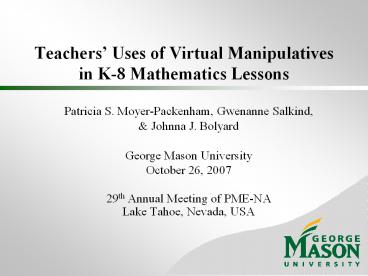Teachers - PowerPoint PPT Presentation
Title:
Teachers
Description:
Teachers' Uses of Virtual Manipulatives in K-8 Mathematics Lessons ... Quilt. Spinners. Tangrams. Triangles. Virtual Manipulatives Used Most Frequently. Geoboards (11 ... – PowerPoint PPT presentation
Number of Views:161
Avg rating:3.0/5.0
Title: Teachers
1
Teachers Uses of Virtual Manipulatives in K-8
Mathematics Lessons
- Patricia S. Moyer-Packenham, Gwenanne Salkind,
- Johnna J. Bolyard
- George Mason University
- October 26, 2007
- 29th Annual Meeting of PME-NA
- Lake Tahoe, Nevada, USA
2
Goals of the Presentation
Examine teachers uses of virtual manipulatives
in mathematics lessons across Grades K-8
- Identify the virtual manipulatives teachers use
- Describe the mathematics content taught with
virtual manipulatives - Classify the ways teachers and students use
virtual manipulatives
3
What are Virtual Manipulatives?
- Interactive
- Web-based
- Visual representation of a dynamic object
- Presents opportunities for constructing
mathematical knowledge - Moyer, Bolyard, Spikell (2002)
4
Review of Research
- Representations are signs, characters, icons, or
objects that stand for, or represent something
else (Goldin, 2003). - Dual Coding Theory Information for memory is
processed and stored by two interconnected
systems verbal codes and visual codes. When
learners are presented with both visual and
verbal codes, there is an additive effect on
their recall of information (Clark Paivio,
1991). - Virtual manipulatives include verbal codes (i.e.,
letters, numbers, and words) and visual codes
(i.e., pictures) presented simultaneously.
5
Research Questions
- What virtual manipulatives are used by teachers
in mathematics lessons? - How are they used?
6
Participants
- 116 teachers
- Kindergarten through Grade 8
- Same school district
- Teaching experience
- Range 1-32 years
- Average 12 years
- Teaching Level
- 67 at Elementary
- 33 at Secondary
7
Mathematics Institutes
- One-week during the summer (40 hours)
- Followed by 4 formal meetings during the school
year (8 hours) - 4 grade bands (K-2, 3-4, 5-6, 7-8)
- 2 sections of each group for a total of 8 groups
- Taught by 4 instructors
- Readings, discussions, hands-on experiences
including the use of virtual manipulatives
8
Data Sources
- Each teacher developed 5 lessons
- Lessons were taught in their classrooms
- Written lesson plans were collected
- 95 lesson plans included virtual manipulatives
- 28 Grades K-2
- 16 Grades 3-4
- 32 Grades 5-6
- 24 Grades 7-8
9
Analyses
- Mathematics content
- Types of virtual manipulatives used within
grade-specific groups - Categories describing how the virtual
manipulatives were used - Connections between virtual and physical
manipulatives
10
Mathematics Content
- Number Operations (35)
- Geometry (32)
- Algebra (13)
- Measurement (13)
- Data Analysis Probability (7)
11
Virtual Manipulatives Used
- Angles
- Arrays
- Attribute Blocks
- Balance
- Balls in Bags
- Base-Ten Blocks
- Box Plots
- Clocks
- Color Chips
- Color Tiles
- Factor Trees
- Fractals
- Fraction Bars
- Fraction Circles
- Fraction Squares
- Geoblocks
- Geometric Solids
- Histograms
- Lets Make a Deal
- Money
- Number Lines
Pattern Blocks Peg Puzzles Pentominoes Percent
Bars Protractors Quilt Spinners Tangrams Triangles
12
Virtual Manipulatives Used Most Frequently
- Geoboards (11)
- Pattern Blocks (11)
- Tangrams (9)
- Base-ten Blocks (8)
13
VMs Used Across Grade-Specific Groups
Grade-Specific Groups Grade-Specific Groups Grade-Specific Groups Grade-Specific Groups Grade-Specific Groups
Virtual Manipulatives K-2 (N27) 3-4 (N15) 5-6 (N30) 7-8 (N23) All (N95)
Base-Ten Blocks 11 20 7 0 8
Fraction Circles 0 7 10 4 5
Fraction Squares 4 0 7 4 4
Geoboards 4 0 17 17 11
Geometric Solids 0 7 3 4 3
Number Lines 0 7 3 4 3
Pattern Blocks 22 13 0 9 11
Tangrams 19 7 10 0 9
14
How Virtual Manipulatives Were Used
Grade-Specific Groups Grade-Specific Groups Grade-Specific Groups Grade-Specific Groups Grade-Specific Groups
Category K-2 (N27) 3-4 (N15) 5-6 (N30) 7-8 (N23) All (N95)
Investigate 52 33 47 43 45
Understand 29 47 33 43 37
Intro 11 20 13 13 14
Game 4 0 3 0 2
Other (Aide, Model, Extend) 4 0 3 0 2
15
How Virtual Manipulatives Were Used
Grade-Specific Groups Grade-Specific Groups Grade-Specific Groups Grade-Specific Groups Grade-Specific Groups
Category K-2 (N27) 3-4 (N15) 5-6 (N30) 7-8 (N23) All (N95)
Used Only VM 37 40 77 44 52
Used PM, Then VM 59 53 17 52 42
Used VM, Then PM 0 0 7 0 2
Simultaneous Use 4 7 0 4 3
16
Key Findings and Implications
- A variety of virtual manipulatives were used by
teachers for mathematics instruction across
Grades K through 8. - The majority of lessons were in the Number
Operations and Geometry Standards - We were not surprised that geoboards, pattern
blocks, base-ten blocks, and tangrams were the
most frequently used virtual manipulatives as
these are commonly used physical manipulatives.
17
Key Findings and Implications
- Virtual manipulatives were frequently used to
investigate mathematical ideas or develop
understandings of mathematical concepts. - An approximately equal number of lessons used
virtual manipulatives alone as used virtual
manipulatives together with physical
manipulatives. - When there was a combination of virtual
manipulatives and physical manipulatives,
teachers used the physical manipulative first.
18
- Patricia S. Moyer-Packenhampmoyer_at_gmu.edu
- Gwenanne Salkindgsalkind_at_gmu.edu
- Johnna J. Bolyardjohnna.bolyard_at_mail.wvu.edu































